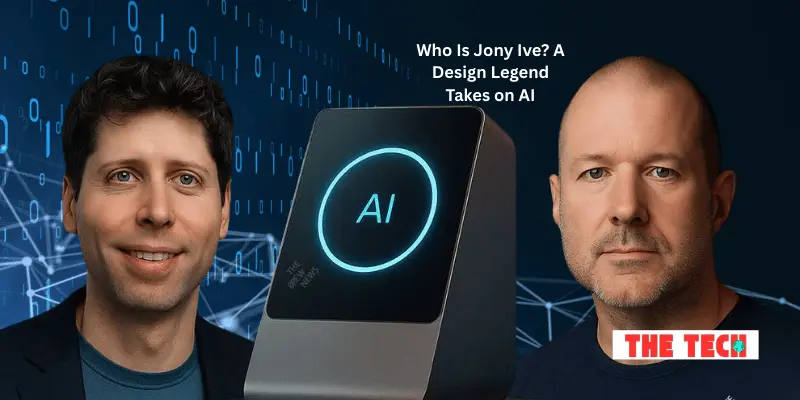Apple’s Jony Ive Partners with OpenAI to Design the Future of AI Hardware
Published: May 25, 2025
This is big news in the technology world! Apple’s Jony Ive Partners with OpenAI, yes, the brilliant mind behind Apple’s most iconic products, to design a new kind of AI device.
This exciting partnership aims to shape how we interact with artificial intelligence in the future, not just through apps or screens but through beautifully crafted physical devices.
Let’s break it down in simple terms and see why this collaboration is making headlines.
Who Is Jony Ive? A Design Legend Takes on AI

If you’ve ever used an iPhone, iPad, or MacBook, you’ve seen Jony Ive’s work firsthand.
He was Apple’s Chief Design Officer for over two decades and helped create the sleek, minimal, and elegant look that made Apple products so popular.
In 2019, he left Apple to start his own design firm, LoveFrom. Since then, he’s worked with companies like Airbnb and Ferrari.
But now, he’s entering the world of artificial intelligence — and not alone.
What Is OpenAI? The Brains Behind ChatGPT
You probably know OpenAI as the company behind ChatGPT, the AI chatbot that can write emails, answer questions, and even help with coding.
But OpenAI isn’t just about software — it wants to make AI more useful and accessible in real life. And that’s where this new partnership with Jony Ive comes in.
OpenAI, led by CEO Sam Altman, believes the next big leap is to take AI beyond the screen — to make it part of our everyday lives through innovative, helpful, and thoughtfully designed devices.
What’s This New Project All About?
Here’s the exciting part: Jony Ive and Sam Altman co-founded a new startup called io — pronounced like “eye-oh” — and OpenAI just bought it.
They’re now working together to design a brand-new type of AI hardware. Think of it as the “iPhone of artificial intelligence (AI)” — a device just as revolutionary as the iPhone in 2007.
Unlike smartphones or smart speakers today, this device might not even have a screen.
Instead, it’s focused on ambient computing—meaning it could blend into your environment and help you naturally without needing to tap or type anything.
Who’s Involved? An All-Star Team
This project isn’t just about two big names — it’s bringing together a dream team of designers and tech experts.
Many of them are former Apple employees who worked with Jony Ive. The team also includes top engineers from OpenAI who helped build the GPT models you use today.
They’ve set up a beautiful 32,000-square-foot workspace in Jackson Square, San Francisco, where the magic is happening.
This office is the headquarters for their hardware development, where they’re dreaming up the next generation of AI devices.
What Kind of Device Are They Building?
We don’t know precisely what the product will look like yet, but based on reports, here’s what we can expect:
A screenless or minimal-screen device that doesn’t feel like a typical gadget.
Built with voice-first interaction in mind — you talk to it, and it responds smartly.
Powered by OpenAI’s latest GPT-4o model, which understands text, voice, images, and more.
It could act like a personal AI assistant that knows your habits, helps with tasks, and feels more like a companion than a tool.
The team has even said they were inspired by the AI character “Samantha” in the movie Her — an always-present, thoughtful assistant you talk to naturally.
Why Does This Matter?
This collaboration could change how we use technology in our daily lives.
Instead of being glued to our phones or screens, we might have AI devices that blend into our surroundings, help us quietly and efficiently, and reduce digital distractions.
Plus, this is a big step for OpenAI.
The company is already a leader in software AI, but this move into hardware shows it wants to compete with tech giants like Apple, Google, and Amazon—not just in software but also in devices.
How Much Is Being Invested?
A lot of money is going into this idea. OpenAI reportedly spent $6.5 billion to acquire io. And that’s just the beginning — more funding could be coming.
Emerson Collective, a significant impact investment group founded by Laurene Powell Jobs (Steve Jobs’ widow), is in talks to invest up to $1 billion to support the project.
With this financial backing, the team has the resources to take significant, creative and technological risks.
What’s the Timeline? When Can We See It?
Don’t expect to see this product on shelves next month. According to insiders, the team aims to release something by late 2025 or early 2026.
They’re taking their time to get everything right — from design to functionality to privacy and ethics.
Sam Altman has said this is a long-term project, and they’re not rushing it. Their goal is to build something truly useful and revolutionary, not just another gadget.
Final Thoughts – A New Era in AI + Design
Jony Ive and the OpenAI team’s collaboration is one of the most exciting developments in tech right now.
It’s not just about building a new device—it’s about rethinking how we live with technology, communicate with AI, and bring beauty and simplicity back to our digital lives.
With brilliant design, cutting-edge AI, and big dreams behind it, this project could usher in a whole new era of intelligent hardware — one that’s smart, helpful, and designed to fit naturally into our world.
FAQs
Jony Ive is the legendary designer behind Apple’s most famous products. His partnership with OpenAI brings world-class design to the world of AI.
An innovative, screenless (or minimal-screen) device that uses voice and AI to assist you in everyday tasks, like a personal AI companion.
The project is in early stages, but we might see a product by 2026.
OpenAI has invested $6.5 billion, and Emerson Collective may add another $1 billion.
The team is moving to a new office in Jackson Square, San Francisco.
Bonus Info Points
- Inspired by Humane’s AI Pin: Sam Altman has previously backed Humane, a company that built the AI Pin — a wearable, screenless assistant. Though Humane’s launch wasn’t perfect, the concept of screenless AI continues to inspire this new venture with Jony Ive.
- No More Traditional Screens? Reports suggest that this new device might abandon traditional screens altogether. It could use projected interfaces, voice, or even spatial audio, offering a more natural and immersive interaction with AI.
- Focus on Ambient Computing: Ambient computing means technology that quietly works in the background — it doesn’t demand attention, but is always ready to help. This project aims to make AI blend into your environment, like lighting, sound, or air — always around, but never in your face.
- Using GPT-4o: Multimodal Brilliance: The device is expected to use GPT-4o, OpenAI’s most advanced model that understands and interacts using voice, text, vision, and audio, making it perfect for natural, real-world interaction.
- Privacy by Design: Given Jony Ive’s design values and OpenAI’s increasing focus on trust, the device could feature built-in privacy protections, such as on-device processing, no constant recordings, and user-controlled data.
- Human-Centred AI: Instead of just a tech product, the focus is on human-first experiences — AI that feels less robotic and more like a thoughtful assistant, guide, or companion.
- Collaborative Product Philosophy: The io team encourages open collaboration, emphasising feedback, design experimentation, and long-term vision rather than quick releases. They want to build something meaningful, not just trendy.
- Billion-Dollar Bet on the Future: The scale of investment — $6.5B from OpenAI and potentially $1B from Emerson Collective — signals just how serious this venture is. It’s not a side project. It’s a bold bet on the future of personal AI hardware.

- Be Respectful
- Stay Relevant
- Stay Positive
- True Feedback
- Encourage Discussion
- Avoid Spamming
- No Fake News
- Don't Copy-Paste
- No Personal Attacks



- Be Respectful
- Stay Relevant
- Stay Positive
- True Feedback
- Encourage Discussion
- Avoid Spamming
- No Fake News
- Don't Copy-Paste
- No Personal Attacks





